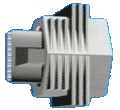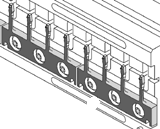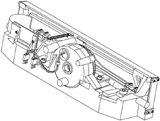Matrix printing technology
Today we present to your attention a detailed post about the technology of matrix printing.
Matrix printing - is perhaps the most respectable by age, but still enjoys deserved popularity. The essence of the technology is simple: to get an image, dots are drawn on the paper, which are obtained by hitting the printhead needles through the ink ribbon over the paper. Needles are collected in vertically arranged rows. By the number of needles, two types of printers are distinguished - 9 needles (they have one row of 9 needles in the print heads) and 24-needle ones - they have 2 rows of 12 needles each. There are also printers in which 18 needles are located in the print head. Such heads are used in high-speed printers. Needles are located in the head in the form of a diamond. This arrangement provides fast printing with the same impact force on the central and extreme needles. The print quality of this printer is fully consistent with the print quality of a 9-needle printer. Needle “excess” is used to increase speed, but not quality.


When working, the print head moves along the carriage and needle, successively flying out of it, put dots on the paper, thereby forming an image (usually letters and numbers, but printing is also possible in the graphic). According to the method of image formation, classical matrix printers are called SIDM devices (from Serial Impact Dot-Matrix, a sequential impact point-matrix technology). Linear matrix printers can be considered “non-classic” matrix printers. These are quite massive units, usually replacing in large organizations failing and ADC modes. The principle of image construction is different from the one described above.

')
The basis of the linear-matrix printer is the so-called. Shuttle: an assembly consisting of a frame with a width across the entire width of the print, on which horizontally, along the whole frame are installed printing hammers. During operation, that part of the shuttle, on which the hammers are mounted, reciprocates with a high frequency and amplitude equal to the distance between adjacent hammers (usually several millimeters), driven by the shuttle crank mechanism. Depending on the speed of the printer, different types of frets are used with different numbers of hammers (the higher the speed, the more hammers in the frete).


When moving from one dead point to another, each of the hammers, if necessary, strikes the tape with paper, which causes the full horizontal line of the future image to form on each paper from edge to edge, after which the paper moves one step further and the shuttle begins to move in back side. Thus, the image line by line is formed on paper. Therefore, even the print speed of such a printer is not measured in characters per second, like a regular SIDM printer, but in lines per minute (when printing text) or in inches per minute if graphics are printed. When printing, the ribbon moves either to one or the other side, rewinding from one reel to another (as in old typewriters). Regarding the bed with hammers, it is angled, which makes it possible to wear it fairly evenly. True, this also gives the possibility of uneven tape wear in the event that printing is primarily carried out on narrow paper (A4 format), only one half of the tape wears out (in the figure below, the upper part of the tape will wear out when printing with the left part of the shuttle), and the second remains untouched. If such printing is really necessary, then it is recommended to turn over the reels from time to time, forcing one or the other half of the ink ribbon to work.

There are two technologies that drive a needle or a hammer in a dot-matrix printer - this is ballistic technology and printing technology with stored energy. Ballistic technology is based on electromagnets located on each of the needles. When power is supplied to the electromagnet, it attracts the “heel” of the needle (sales may vary depending on the manufacturer) and it is set in motion. The needle returns to its original position under the action of a spring. In the case of technology with stored energy, in the head on each of the needles there is a constantly bent spring held by a permanent magnet.


A winding made of a permanent magnet, when energized, creates a small magnetic field that compensates for the magnetic force of the permanent magnet. This compensation becomes sufficient for the spring to come off the magnet and the needle attached to it is set in motion. When removing the power from the winding, the spring is again attracted to the permanent magnet, which returns the needle to its original state. Ballistic technology is older, technology with stored energy is newer. Its main advantages over the ballistic one is that the head heats up less during operation (after all, to compensate for the magnet force, a noticeably lower power must be applied to the coil than in the case where the electromagnet puts the needle into action), besides The stored energy depends only on the stiffness of the constantly bent spring, which means it practically does not change with time and on heating. On the other hand, the print heads made by ballistic technology are noticeably smaller in size, which allows saving energy on their movement along the carriage, as well as making more powerful heat exchangers on them.
Being the most respectable by age technology, today the matrix printing has almost ceased to be interesting to home users. However, there are areas of application where it is still impossible to replace it: printing of multi-part forms (customs or commodity invoices); print pin-envelopes for SIM-cards and bank cards; ticket printing; printing on responsible forms and forms, where not only the printed information is important, but also the fact of its application by the impact method.
Sergey Lebedev, OKI Marketing Director
Matrix printing - is perhaps the most respectable by age, but still enjoys deserved popularity. The essence of the technology is simple: to get an image, dots are drawn on the paper, which are obtained by hitting the printhead needles through the ink ribbon over the paper. Needles are collected in vertically arranged rows. By the number of needles, two types of printers are distinguished - 9 needles (they have one row of 9 needles in the print heads) and 24-needle ones - they have 2 rows of 12 needles each. There are also printers in which 18 needles are located in the print head. Such heads are used in high-speed printers. Needles are located in the head in the form of a diamond. This arrangement provides fast printing with the same impact force on the central and extreme needles. The print quality of this printer is fully consistent with the print quality of a 9-needle printer. Needle “excess” is used to increase speed, but not quality.


When working, the print head moves along the carriage and needle, successively flying out of it, put dots on the paper, thereby forming an image (usually letters and numbers, but printing is also possible in the graphic). According to the method of image formation, classical matrix printers are called SIDM devices (from Serial Impact Dot-Matrix, a sequential impact point-matrix technology). Linear matrix printers can be considered “non-classic” matrix printers. These are quite massive units, usually replacing in large organizations failing and ADC modes. The principle of image construction is different from the one described above.

')
The basis of the linear-matrix printer is the so-called. Shuttle: an assembly consisting of a frame with a width across the entire width of the print, on which horizontally, along the whole frame are installed printing hammers. During operation, that part of the shuttle, on which the hammers are mounted, reciprocates with a high frequency and amplitude equal to the distance between adjacent hammers (usually several millimeters), driven by the shuttle crank mechanism. Depending on the speed of the printer, different types of frets are used with different numbers of hammers (the higher the speed, the more hammers in the frete).

hammers are combined into modules called frets

Shuttle
When moving from one dead point to another, each of the hammers, if necessary, strikes the tape with paper, which causes the full horizontal line of the future image to form on each paper from edge to edge, after which the paper moves one step further and the shuttle begins to move in back side. Thus, the image line by line is formed on paper. Therefore, even the print speed of such a printer is not measured in characters per second, like a regular SIDM printer, but in lines per minute (when printing text) or in inches per minute if graphics are printed. When printing, the ribbon moves either to one or the other side, rewinding from one reel to another (as in old typewriters). Regarding the bed with hammers, it is angled, which makes it possible to wear it fairly evenly. True, this also gives the possibility of uneven tape wear in the event that printing is primarily carried out on narrow paper (A4 format), only one half of the tape wears out (in the figure below, the upper part of the tape will wear out when printing with the left part of the shuttle), and the second remains untouched. If such printing is really necessary, then it is recommended to turn over the reels from time to time, forcing one or the other half of the ink ribbon to work.

There are two technologies that drive a needle or a hammer in a dot-matrix printer - this is ballistic technology and printing technology with stored energy. Ballistic technology is based on electromagnets located on each of the needles. When power is supplied to the electromagnet, it attracts the “heel” of the needle (sales may vary depending on the manufacturer) and it is set in motion. The needle returns to its original position under the action of a spring. In the case of technology with stored energy, in the head on each of the needles there is a constantly bent spring held by a permanent magnet.

ballistic technology

stored energy printing technology
A winding made of a permanent magnet, when energized, creates a small magnetic field that compensates for the magnetic force of the permanent magnet. This compensation becomes sufficient for the spring to come off the magnet and the needle attached to it is set in motion. When removing the power from the winding, the spring is again attracted to the permanent magnet, which returns the needle to its original state. Ballistic technology is older, technology with stored energy is newer. Its main advantages over the ballistic one is that the head heats up less during operation (after all, to compensate for the magnet force, a noticeably lower power must be applied to the coil than in the case where the electromagnet puts the needle into action), besides The stored energy depends only on the stiffness of the constantly bent spring, which means it practically does not change with time and on heating. On the other hand, the print heads made by ballistic technology are noticeably smaller in size, which allows saving energy on their movement along the carriage, as well as making more powerful heat exchangers on them.
Being the most respectable by age technology, today the matrix printing has almost ceased to be interesting to home users. However, there are areas of application where it is still impossible to replace it: printing of multi-part forms (customs or commodity invoices); print pin-envelopes for SIM-cards and bank cards; ticket printing; printing on responsible forms and forms, where not only the printed information is important, but also the fact of its application by the impact method.
Sergey Lebedev, OKI Marketing Director
Source: https://habr.com/ru/post/158275/
All Articles